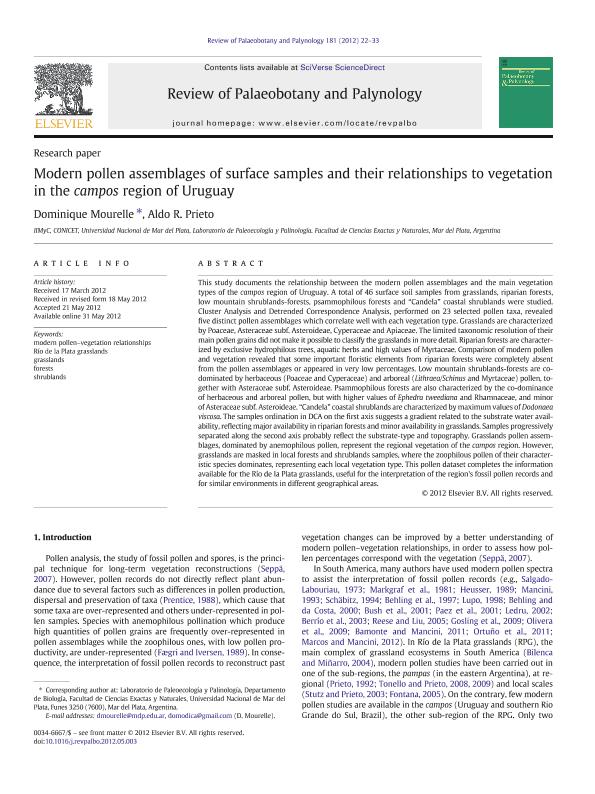Mostrar el registro sencillo del ítem
dc.contributor.author
Mourelle Civano, Dominique

dc.contributor.author
Prieto, Aldo Raul

dc.date.available
2019-03-11T20:12:09Z
dc.date.issued
2012-08
dc.identifier.citation
Mourelle Civano, Dominique; Prieto, Aldo Raul; Modern pollen assemblages of surface samples and their relationships to vegetation in the campos region of Uruguay; Elsevier Science; Review of Palaeobotany and Palynology; 181; 8-2012; 22-33
dc.identifier.issn
0034-6667
dc.identifier.uri
http://hdl.handle.net/11336/71396
dc.description.abstract
This study documents the relationship between the modern pollen assemblages and the main vegetation types of the campos region of Uruguay. A total of 46 surface soil samples from grasslands, riparian forests, low mountain shrublands-forests, psammophilous forests and "Candela" coastal shrublands were studied. Cluster Analysis and Detrended Correspondence Analysis, performed on 23 selected pollen taxa, revealed five distinct pollen assemblages which correlate well with each vegetation type. Grasslands are characterized by Poaceae, Asteraceae subf. Asteroideae, Cyperaceae and Apiaceae. The limited taxonomic resolution of their main pollen grains did not make it possible to classify the grasslands in more detail. Riparian forests are characterized by exclusive hydrophilous trees, aquatic herbs and high values of Myrtaceae. Comparison of modern pollen and vegetation revealed that some important floristic elements from riparian forests were completely absent from the pollen assemblages or appeared in very low percentages. Low mountain shrublands-forests are co-dominated by herbaceous (Poaceae and Cyperaceae) and arboreal (Lithraea/Schinus and Myrtaceae) pollen, together with Asteraceae subf. Asteroideae. Psammophilous forests are also characterized by the co-dominance of herbaceous and arboreal pollen, but with higher values of Ephedra tweediana and Rhamnaceae, and minor of Asteraceae subf. Asteroideae. "Candela" coastal shrublands are characterized by maximum values of Dodonaea viscosa. The samples ordination in DCA on the first axis suggests a gradient related to the substrate water availability, reflecting major availability in riparian forests and minor availability in grasslands. Samples progressively separated along the second axis probably reflect the substrate-type and topography. Grasslands pollen assemblages, dominated by anemophilous pollen, represent the regional vegetation of the campos region. However, grasslands are masked in local forests and shrublands samples, where the zoophilous pollen of their characteristic species dominates, representing each local vegetation type. This pollen dataset completes the information available for the Río de la Plata grasslands, useful for the interpretation of the region's fossil pollen records and for similar environments in different geographical areas. © 2012 Elsevier B.V.
dc.format
application/pdf
dc.language.iso
eng
dc.publisher
Elsevier Science

dc.rights
info:eu-repo/semantics/openAccess
dc.rights.uri
https://creativecommons.org/licenses/by-nc-sa/2.5/ar/
dc.subject
Forests
dc.subject
Grasslands
dc.subject
Modern Pollen-Vegetation Relationships
dc.subject
RÍO de La Plata Grasslands
dc.subject
Shrublands
dc.subject.classification
Otras Ciencias de la Tierra y relacionadas con el Medio Ambiente

dc.subject.classification
Ciencias de la Tierra y relacionadas con el Medio Ambiente

dc.subject.classification
CIENCIAS NATURALES Y EXACTAS

dc.title
Modern pollen assemblages of surface samples and their relationships to vegetation in the campos region of Uruguay
dc.type
info:eu-repo/semantics/article
dc.type
info:ar-repo/semantics/artículo
dc.type
info:eu-repo/semantics/publishedVersion
dc.date.updated
2019-03-08T16:45:12Z
dc.journal.volume
181
dc.journal.pagination
22-33
dc.journal.pais
Países Bajos

dc.journal.ciudad
Amsterdam
dc.description.fil
Fil: Mourelle Civano, Dominique. Consejo Nacional de Investigaciones Científicas y Técnicas. Centro Científico Tecnológico Conicet - Mar del Plata. Instituto de Investigaciones Marinas y Costeras. Universidad Nacional de Mar del Plata. Facultad de Ciencias Exactas y Naturales. Instituto de Investigaciones Marinas y Costeras; Argentina. Universidad Nacional de Mar del Plata. Facultad de Ciencias Exactas y Naturales. Departamento de Biología. Laboratorio de Paleoecología y Palinologia; Argentina
dc.description.fil
Fil: Prieto, Aldo Raul. Consejo Nacional de Investigaciones Científicas y Técnicas. Centro Científico Tecnológico Conicet - Mar del Plata. Instituto de Investigaciones Marinas y Costeras. Universidad Nacional de Mar del Plata. Facultad de Ciencias Exactas y Naturales. Instituto de Investigaciones Marinas y Costeras; Argentina. Universidad Nacional de Mar del Plata. Facultad de Ciencias Exactas y Naturales. Departamento de Biología. Laboratorio de Paleoecología y Palinologia; Argentina
dc.journal.title
Review of Palaeobotany and Palynology

dc.relation.alternativeid
info:eu-repo/semantics/altIdentifier/doi/https://doi.org/10.1016/j.revpalbo.2012.05.003
dc.relation.alternativeid
info:eu-repo/semantics/altIdentifier/url/https://www.sciencedirect.com/science/article/pii/S0034666712001364
Archivos asociados
